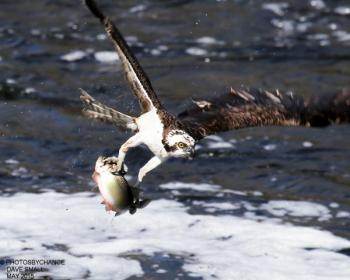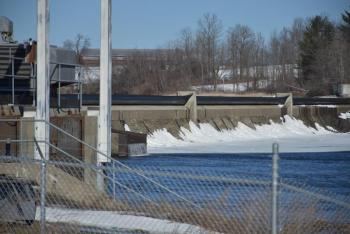Restoring Maine’s River Connections for Fish, Birds, and People
If you live near a river, you may be able to tell when an amazing biological miracle is underway each spring, by the sights and sounds of birds. In spring, as the days grow warmer, fish that have been far out to sea are, seemingly miraculously drawn back to the river where their parents and countless ancestors before them had come to reproduce. The instinctual pull brings them away from the salty open depths to the strong freshwater flows of Maine’s rivers and lakes that are filled by streams that drop down from Maine’s mountains and forests.
Originally, these freshwater flows made an unimpeded connection between land and sea, and the fish likewise made unimpeded journeys back and forth from the sea to rivers, lakes, ponds, and streams. Robust populations of alewives, shad, blueback herring, eels, and Atlantic salmon provided food for birds and people at places in the rivers where fish were confined as they passed natural obstacles like rapids and narrow, shallower places in the river.
Over time, we humans added unnatural obstacles in the form of dams. This eliminated almost all the opportunity for the fish to reproduce across most of their former breeding area, causing populations of all of these sea-run fish to drop precipitously in numbers. Some, like the Atlantic salmon, have become just ghostly remnant populations, holding on by a thread.
But when dams have been removed, fish experience population recoveries. In the Kennebec in 1999, removal of the Edwards Dam in Augusta, followed about a decade later by removal of the Ft. Halifax Dam on the Sebasticook (a Kennebec tributary), has allowed huge numbers of alewives and blueback herring to increase into the millions. The Penobscot River is experiencing similar results since removal of two dams and the construction of an effective, nature-like bypass that allow all of Maine’s native fish populations to get where they need to go to spawn.
When numbers of fish come back like this, bird populations respond as well. Ospreys, bald eagles, and great blue herons are among the most obvious birds that are drawn to feed on these fish each spring. People, too, are drawn to the amazing biological spectacle. Indigenous people once survived by harvesting from this abundant resource until dams took that food source away. Today, a portion of the alewives are taken by fisherman to use for lobster bait. Thousands of people now come to marvel at the biological spectacle of uncountable numbers of silvery fish darting up through the fishway at the well-known Damariscotta Mills fish ladder.
But there is still so much more that needs to be done to bring our rivers, streams, and lakes back to life to save some fish species. Without removal of four dams on the Kennebec between Waterville and Skowhegan, the Atlantic salmon will become extinct. Those dams block access to the Sandy River spawning grounds, and Atlantic salmon are among the species that do not use fishways. Populations of alewives and blueback herring will not reach their full potential to replenish the health of the Gulf of Maine ecosystem—and the fisheries that rely on it—without dam removal. Multiple dams on Cobbosseecontee Stream in Gardiner similarly don’t allow alewives to access the lakes and ponds where they once thrived. A local group called Upstream has made great strides in galvanizing support and, working with all the right partners, has made an undeniable case for fish passage in the stream, but a few vocal opponents area fearful of change.
It’s time to move forward the reconnection of our inland waters with our famously rich coastal ecosystem and allow restoration back to health. Fish, birds, other wildlife will benefit and us humans will, too.
The Natural Resources Council of Maine (NRCM), working with other conservation groups, was instrumental in removal of the Edwards and Fort Halifax Dams. They and the many dedicated stakeholder groups saw the vision of a restored Penobscot River through to completion. Now they are working to ensure removal of the four dams that block passage of endangered Atlantic salmon on the Kennebec. To learn more about this vital work, including how you can help make a difference, contact NRCM and visit https://www.nrcm.org/programs/waters/kennebec-restoration/.
Jeffrey V. Wells, Ph.D., is a Fellow of the Cornell Lab of Ornithology and Vice President of Boreal Conservation for National Audubon. Dr. Wells is one of the nation's leading bird experts and conservation biologists and author of the “Birder’s Conservation Handbook.” His grandfather, the late John Chase, was a columnist for the Boothbay Register for many years. Allison Childs Wells, formerly of the Cornell Lab of Ornithology, is a senior director at the Natural Resources Council of Maine, a nonprofit membership organization working statewide to protect the nature of Maine. Both are widely published natural history writers and are the authors of the popular books, “Maine’s Favorite Birds” (Tilbury House) and “Birds of Aruba, Bonaire, and Curaçao: A Site and Field Guide,” (Cornell University Press).






























